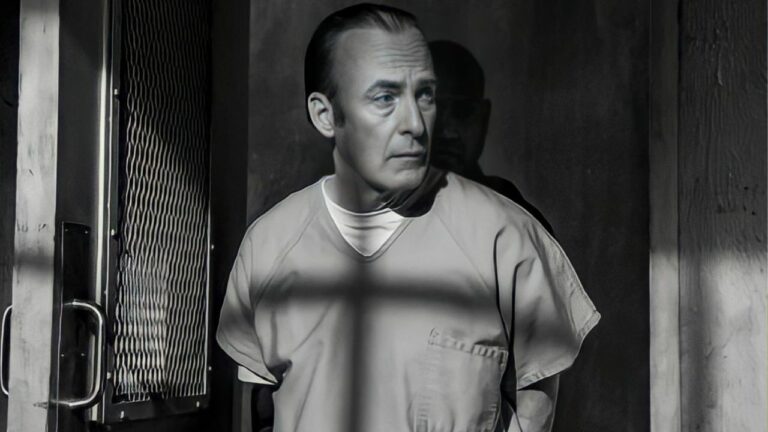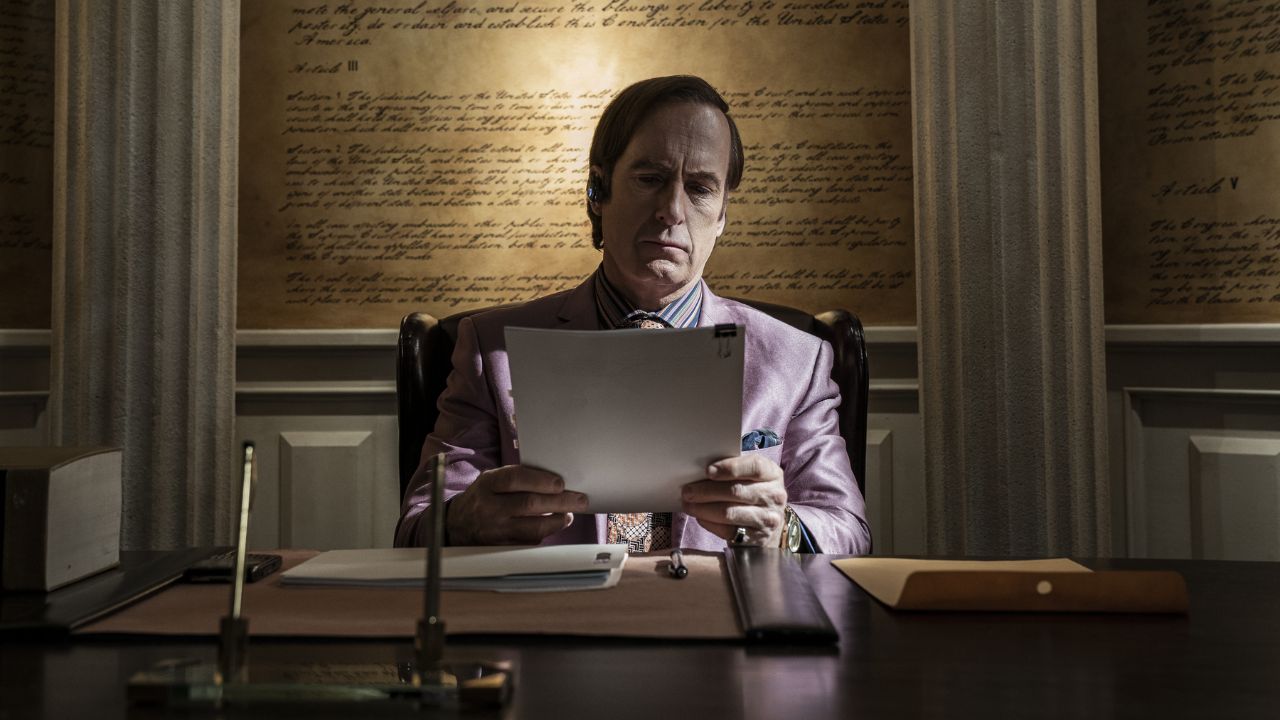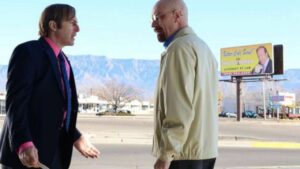“Better Call Saul” Season 6’s finale gives Jimmy McGill one last roll of the dice. The thirteenth episode of Season 6, chillingly titled “Saul Gone,” answered a bunch of burning fan questions and tied up some serious loose ends.
It served as a gut-wrenching goodbye to one of TV’s most beloved prequels and unexpectedly brilliant dramas. Better Call Saul has more than earned its place alongside Breaking Bad as a television heavyweight, and all but perfected the art of spinoffs.
Better Call Saul’s Season 6 finale broke us down, now it’s time to return the favor. Let’s get into the explanation of the much-awaited finale.
1. How does Better Call Saul end?
After a little United States v. Saul Goodman legal action, Jimmy McGill ended up with 86 years in prison as Walter White’s “indispensable” criminal lawyer.
After going down a dark path, over the past few seasons, Saul finally turned a corner and confessed to all of his crimes, clearing Kim Wexler’s name.
Previously in Better Call Saul Season 6, Jimmy McGill made the fatal mistake of getting greedy. Despite successfully starting a new life as “Gene Takavic” in Omaha, Jimmy couldn’t resist the lure of criminality.
He got caught out by Marion (Carol Burnett), who promptly informed the authorities regarding the presence of Heisenberg’s accomplice in her kitchen. On the other hand, Kim Wexler’s torrid new life in Florida was turned upside-down by a surprise phone call from Jimmy.
The phone call prompted her to come clean, signing a full confession to the Howard Hamlin scam and their role in his murder.
Better Call Saul’s series finale begins with Jimmy on the run, charting one last bid for freedom and all the twists that follow. Along the way, a series of flashbacks to unseen moments from both “Better Call Saul” and “Breaking Bad” explains Jimmy’s decisions in the present.
When all is said and done, the legend of Jimmy McGill is finally drawn to a definitive end that occupies the bitter end of bittersweet.

2. Ghosts of Goodman’s past
Better Call Saul’s final episode includes a series of flashbacks. One opposite Jonathan Banks as Mike Ehrmantraut, one opposite Bryan Cranston as Walter White, and one opposite Michael McKean as Chuck McGill.
All three are connected by the overarching theme of regret and hark back to an Easter egg from Better Call Saul’s Season 6 premiere. Jimmy’s first ghost of their criminal past is Mike. To kill time as they cross the desert, the lawyer asks what Mike would change if he had a time machine.
After initially picking a date in 2001(presumably when his son, Matty, died) Mike settles on the first time he took a bribe. He would’ve nipped his dark streak in the bud.
Matty died after reluctantly accepting a police bribe on his father’s advice, so Mike believes that if he’d never been dirtied, his son would still be alive.
In a second flashback, Jimmy asks the same question as Walter White. Walter cites leaving Gray Matter as his biggest regret- a typically self-centered answer that speaks to his lust for greatness and glory.
In both scenes, Jimmy’s replies are meaningless. He tells Mike he’d use a time machine to invest in Berkshire Hathaway and become a billionaire and gives Walt some story about injuring his knee during a “slip ‘n’ fall” scam.
Needless to say, both are just Jimmy deflecting, and his true regret lies hidden within the “time machine” question itself.
Throughout “Better Call Saul” Season 6, a copy of HG Wells’ The Time Machine has been shown in Jimmy’s possession. The finale reveals this originally belonged to his brother, Chuck.
The real moment Jimmy McGill longs to change is running his brother’s career “Better Call Saul” Season 3- the act that led to Chuck taking his own life.

3. Why Betsy Brandt’s Marie Schrader cameo is so important?
We knew about Bryan Cranston and Aaron Paul’s cameo was confirmed in advance. Better Call Saul Season 6’s finale drops a surprise cameo from Betsy Brandt as Marie Schrader.
As the widow of a DEA agent who died chasing down Heisenberg and his cohorts, Marie is permitted to observe Jimmy McGill’s sentence meeting. Jimmy makes a point of inviting Hank’s wife into the room.
This is likely for Jimmy to send the prosecution a message: “If I can look directly in a widow’s eye and lie through my teeth, I can probably convince at least one juror I’m telling the truth.”
Betsy Brandt’s cameo shows that the ramifications of Breaking Bad’s “Ozymandias” episode are still being felt. This makes Hank’s death an even bigger deal. Jimmy performing his victim act in Marie’s face then shows how morally far he’s sunk as “Better Call Saul’s ending looms, setting up the eventual redemption.
4. Saul Goodman’s Plea Bargain Explained
Jimmy McGill hides in a dumpster after grabbing his precious shoebox from Marion’s house. The glance towards his diamonds and the Disappearer’s business card suggests he’s planning yet another extraction. But the police catch up before he gets the opportunity.
Languishing in his holding cell, etched graffiti reading “MY LAWYER WILL REAM UR ASS” sparks a classic Saul Goodman scheme in Jimmy’s mind. He phones his old lawyer friend Bill Oakley, who is now working as a defense attorney as revealed by Francesca earlier in “Better Call Saul” Season 6.
Essentially, Jimmy intends to wrangle a ridiculously light sentence by exploiting his knowledge of the court system. He is aware that only a single juror ruling in the defense’s favor is required, and gives the prosecution team a purview of his “I was a victim too” performance.
The performance was enough to sow doubt in the prosecution as to whether they can secure a conviction. This allowed Jimmy to negotiate a deal whereby he pleads guilty, in exchange for a cushy sentence.
He also preys upon the threat of ending lead prosecutor George Castellano’s flawless record and whittles a life sentence down to seven years at his chosen prison.
5. Why Jimmy finally confesses in court?
Jimmy McGill performs a miracle by negotiating a seven year-sentence, but something changes his mind. When he finally gets his day in court, he throws everything away by spilling his guts in a shocking confession scene.
Saul Goodman’s redemption tentatively begins when he hears Kim Wexler’s confession. But he decides to come clean only during the plane to New Mexico. Through Bill, Jimmy learns that Kim not only signed a legal affidavit regarding the Howard Hamlin incident but showed said affidavit to Howard’s widow.
Kim’s selflessness is the penny-dropping moment Jimmy McGill needed, and he realizes the time has come to cleanse his soul. Jimmy wanted Kim to see he was taking responsibility.
So, he steps off the plane and tells the prosecution a whole bunch of fresh off-screen lies about Kim’s involvement in the Howard scam. This lures Kim to the courtroom, where Jimmy fully intends to rescind those accusations. He just needed her to be there, and briefly incriminating her was the only way.
When Kim left Jimmy in “Better Call Saul” Season 6’s “Fun & Games,” she pointed out how they encouraged each other’s dark sides.
While hard to disagree, Kim inspires Jimmy to come clean in Better Call Saul’s finale proving they’re also capable of bringing out each other’s goodness.

6. The Death of Saul Goodman
The man entering court is Saul Goodman, complete with a garish suit, swagger, and ridiculous name. All of this pompous showmanship is designed to give Saul Goodman one last dance in court.
With each confession, he makes, a part of Saul dies, and a part of Jimmy is reclaimed until only the latter stands before the court. There’s a vital moment in the Better Call Saul finale when Jimmy lays bare his involvement with Heisenberg.
He turns back toward Kim for approval. She remains stony-faced, and Jimmy realizes he hasn’t gone far enough. Returning to the court’s podium, the jail-bound ex-lawyer digs deep and drudges up his deepest regret.
A trauma Jimmy has never properly confronted since it happened in “Better Call Saul” Season 3: making Chuck take his own life. After laying every last sin on the table, Jimmy corrects the judge when she refers to him as “Saul Goodman,” confirming his criminal alter ego is now dead for good.
This perfectly inculcated the series finale title, “Saul Gone.” When he looks back at Kim this time, her expression has softened, showing a mixture of pride and relief. Jimmy McGill is now a man without skeletons clogging up his mental closet.
7. Is Kim Wexler’s Better Call Saul ending happy?
When Better Call Saul revealed Kim’s post-Breaking Bad fate, it wasn’t pretty. A dull job that doesn’t make use of her extraordinary talent, an uninterested partner, and an uncharacteristic refusal to make decisions or choices for herself.
Kim’s life is still pretty bad in Better Call Saul’s season finale, as a lunch break scene proves she can’t even pick between Red Lobster and Topkapi. But Vince Gilligan and Peter Gould do weave the slither of hope into Kim’s Better Call Saul end, as she volunteers at a free legal clinic.
The services provided here are very similar to Kim’s pro bono work from earlier in Better Call Saul Season 6 – offering legal aid to those who can’t afford it. Reclaiming this aspect of her old life represents Kim taking the first step out of her current rut.
Maybe reconnecting with her very first love (law) will eventually coax Kim’s old personality back to the surface and lead to a career change down the line.
Kate’s fate isn’t happy in the traditional sense, but her new job allows the audience to imagine things can get better. Better Call Saul’s finale never confirmed whether Kim still gets sued by Cheryl Hamlin.
Jimmy’s confession was inspired by Kim. It was never about saving Kim since this would’ve negated her redemption arc. Kim is still being punished for her “Better Call Saul” wrongdoing… but there are bright spots to be found.

“Better Call Saul” leaves audiences to assume Jimmy McGill spends the rest of his life incarcerated. The final shot of Kim walking away represents the last time they’ll ever see each other. While hardly the most uplifting conclusion, Jimmy dies an honest man.
In the words of his brother, Chuck, during Better Call Saul’s series finale flashback,
There’s no shame in going back and changing your path.
Chuck
8. About Better Call Saul
Better Call Saul is an American crime drama television series created by Vince Gilligan and Peter Gould. It is a prequel and spin-off to the popular award-winning franchise “Breaking Bad”.
Set in the early to mid-2000s in Albuquerque, New Mexico, ‘Better Call Saul’ follows former conman Jimmy McGill’s journey to becoming a sleazy criminal defense lawyer under the moniker of Saul Goodman.
The series premiered on February 8, 2015 on AMC. The series finale aired on August 15, 2022 after a successful run of six seasons.









No Comments on Did Saul Goodman confess? Better Call Saul Ending Explained